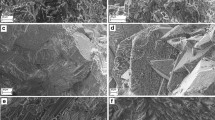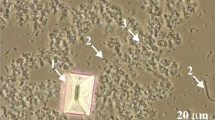Abstract
To find a more efficient solution for chemolysis of urinary calculi, several organic acids were chosen to form solutions by consulting the composition of a classic solution, Suby G. The solutions together with Renacidin, another classic solution, were designed to react with the 4 phosphate components of urinary stone. The processes were real-time measured and analysed by a focused beam reflectance measurement, and the efficiency factors were investigated and discussed in detail. The results show that several organic acids, e.g. hydroxyacetic acid, lactic acid and α-ketoglutaric acid, are more efficient than citric acid in dissolving urinary phosphate calculus. The new solutions containing the organic acids are promising for improving chemolysis treatment.





Similar content being viewed by others
References
Krambeck AE, Handa SE, Evan AP, Lingeman JE (2010) Brushite stone disease as a consequence of lithotripsy? Urol Res 38:293–299
Robertson WG (2006) Is prevention of stone recurrence financially worthwhile? Urol Res 34:157–161
Stamatelou KK, Francis ME, Jones CA, Nyberg LM, Curhan GC (2003) Time trends in reported prevalence of kidney stones in the United States: 1976–1994. Kidney Int 63:1817–1823
Pearle MSPY (1996) Renal calculi: a practical approach to medical evaluation and management. In: Andreucci VEFL (ed) International yearbook of nephrology. Oxford University Press, New York, pp 69–80
Schubert G (2006) Stone analysis. Urol Res 34:146–150
Pearle MSPY (1996) Renal calculi: A practical approach to medical evaluation and management. In: Andreucci VEFL (ed) International yearbook of nephrology. Oxford University Press, New York, p 69
Silverman DE, Stamey TA (1983) Management of infection stones: the Stanford experience. Medicine (Baltimore) 62:44–51
Suby HIAF (1943) Dissolution of phosphatic urinary calculi by the retrograde introduction of a citrate solution containing magnesium. NEJM 228:81–91
Mulvaney WP (1959) A new solvent for certain urinary calculi: a preliminary report. J Urol 82:546–548
Dretler SP, Pfister RC, Newhouse JH (1979) Renal-stone dissolution via percutaneous nephrostomy. N Engl J Med 300:341–343
Comarr AE, Kawaichi GK, Morris L, Bors E (1971) Dissolution of renal stones by renacidin in patients with spinal cord injury. Proc Veterans Adm Spinal Cord Inj Conf 18:174–179
Suby HI (1952) Dissolution of urinary calculi. J Urol 68:96–104
Gonzalez RD, Whiting BM, Canales BK (2012) The history of kidney stone dissolution therapy: 50 years of optimism and frustration with renacidin. J Endourol 26:110–118
Xiang-bo Z, Zhi-ping W, Jian-min D, Jian-zhong L, Bao-liang M (2005) New chemolysis for urological calcium phosphate calculi—a study in vitro. BMC Urol 5:9
Suby HI (1944) Dissolution of urinary calculi. Proc R Soc Med 37:609–620
Jacobs D, Heimbach D, Hesse A (2001) Chemolysis of struvite stones by acidification of artificial urine—an in vitro study. Scand J Urol Nephrol 35:345–349
Hou GY, Power G, Barrett M, Glennon B, Morris G, Zhao Y (2014) Development and characterization of a single stage mixed-suspension, mixed-product-removal crystallization process with a novel transfer unit. Cryst Growth Des 14:1782–1793
Li HY, Kawajiri Y, Grover MA, Rousseau RW (2014) Application of an empirical FBRM model to estimate crystal size distributions in batch crystallization. Cryst Growth Des 14:607–616
Acknowledgments
Financial support from the National Natural Science Foundation of China (No. 21276091), Ph.D. Programmes Foundation of the Ministry of Education of China (No. 20120172110010) and Science and Technology Planning Project Foundation of Zhongshan (No. 2014A1FC120) are greatly appreciated.
Conflict of interest
The authors declare that they have no conflict of interest.
Author information
Authors and Affiliations
Corresponding authors
Rights and permissions
About this article
Cite this article
Zhang, J., Wang, S., Hong, J. et al. New potential solutions for the chemolysis of urinary phosphate calculi determined by an in vitro study. Urolithiasis 43, 147–153 (2015). https://doi.org/10.1007/s00240-014-0745-1
Received:
Accepted:
Published:
Issue Date:
DOI: https://doi.org/10.1007/s00240-014-0745-1




